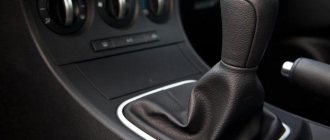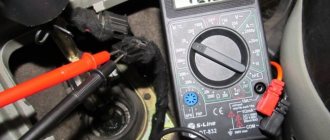To learn how to drive a vehicle with a manual transmission, you will need to make some effort to achieve this goal. Even if the first attempts are not successful, only practical training and a clear understanding of how to get used to a manual transmission allow you to improve your skills.
In this article, we will look at the basic principles of driving a manual car, how to properly drive a manual transmission, and how to engage the manual transmission in reverse.
General principles of driving a car with a manual transmission
First of all, you need to study in advance the features of a manual transmission on a specific car. At the training stage, you should pay attention to the following points:
- make sure that the car is located on a level surface, the parking brake (handbrake) must be applied;
- Depress the clutch pedal all the way;
- For safety reasons, so that the car does not jerk after starting the engine and releasing the clutch, check the gear (at the very beginning the lever should be in neutral position).
- After turning the key and starting the car engine, continue to fully depress the clutch, but at the same time, the gear from “neutral” must be switched to first (direction to the left and up);
- Before removing the car from the handbrake, you must press the brake with your right foot;
- then you need to assess the road situation through the side mirrors and the interior rearview mirror. Having made sure that it is completely safe, we begin to carefully and smoothly release the clutch, while simultaneously removing our right foot from the brake and lightly pressing the gas pedal. As a result, the car will start moving.
To understand how to get used to a manual transmission, you need to take into account the main principle, which is to smoothly depress the gas pedal, as well as slowly release the clutch without any sudden movements. The more often you practice, the faster you will get used to a series of sequential actions.
If you release the clutch ahead of time, jerking will follow and the car will stall. Late release of the clutch also becomes a common occurrence, after which a sharp jerking of the car and a jump in revolutions cannot be avoided. Only practice will help a beginner develop the habit of “feeling” the moment the clutch engages.
If your car engine stalls, follow the following procedure:
- First of all, the car must be put on the handbrake;
- Then set the gear to neutral;
- Depress the clutch all the way and at the same time press the brake pedal, then turn the key and start the engine. Then you need to try to get underway again.
Once the vehicle has started moving, it is important to consider the following when driving:
- Never change gears while the gas pedal is depressed;
- at the moment of transition to the next gear, without pressing the gas pedal, depress the clutch. This will allow you to disconnect the motor from the gearbox and make it possible to switch to the desired gear;
- Having selected the gear you need, switch to it. As a rule, gears need to be switched one at a time, but with experience in certain conditions, switching through 1 step is allowed. During the learning process, jumping through one gear (for example, from first gear directly to third) is unacceptable;
- Having engaged the desired gear, you can release the clutch pedal, and not as smoothly as when starting off in first.
- to switch the gearbox to second, third and other gears, you should increase the speed to 3000-4000 rpm and accelerate sufficiently;
Having accelerated, you need to depress the clutch pedal without pressing the gas pedal, then, after changing gear, release the clutch pedal. When driving, you cannot keep your foot on the clutch, as even the slightest pressure can cause premature wear of the clutch. - To slow down a little, rather than stop the car, you need to stop pressing the gas pedal and gently press the brake. The engine will not stall if the speed matches the gear engaged;
- when braking, you may need to depress the clutch in cases where the car begins to twitch when actively reducing speed;
- If the speed is not higher than ten kilometers per hour, it is permissible to switch to neutral gear while simultaneously squeezing the clutch and pressing the brake to completely stop the car.
Adjusting the gear shift control drive
| 1 — reverse locking bracket; | 8 — spherical pin of the gear shift mechanism; |
| 2 — axis stop; | 9 — body floor; |
| 3 — gear shift lever axis; | 10 — ball joint; |
| 4 — axle bushings; | 11 - buffer; |
| 5 — VAZ 210 gear shift lever; | 12 - spring; |
| 6 — spacer sleeve; | 13 - template 67.7834.9527; |
| 7 — spherical washer of the ball joint; | 14 — bracket cover. |
2. In order to ensure free movement of the rod relative to the gear selection rod, the grooves at the end of the rod and the clamp should be widened using a screwdriver. Then place the rod in the neutral position.
3. Next, we go into the car interior and remove the gearbox cover from the handle. You can simply lower it to the very bottom, and install the lever so that its lower (non-bent) end is approximately vertical.
If you have template 67.7834.9527, then set the gear shift knob as follows: with the lever cover removed, install the template in the trim window (number 14 in the diagram above) of the reverse locking bracket.
Next, insert the stop of the axis (2) of the lever (5) into the groove of the template (13) and press it against the template in the transverse direction without causing elastic deformation of the bracket (number 1). Lock the lever (5) in this position.
4. Under the bottom of the car, you need to carefully, without sudden movements of the hand, select the axial play of the rod in the rearward direction and its angular play in the counterclockwise direction (the task is not to move the gear shift lever).
Subtleties and nuances when driving a car with a manual transmission
First of all, when you start to slow down in a car, do not forget that when the speed decreases significantly, you must depress the clutch. Without this, after characteristic twitching, the car engine will stall in gear.
It is also worth noting that in case of slight braking, it is permissible not to depress the clutch, but only if the correct relationship between the driving speed and the selected gear is not violated.
You can also influence the braking process using the gearbox (by downshifting). In fact, by lowering the gear, it is possible to reduce the speed, and in some cases it is possible not to use the brake pedal at all in certain conditions.
For this type of braking, the following must be taken into account:
- to reduce the speed of the car, you must stop pressing the gas pedal;
- go from a high gear to a low gear, while pressing the clutch (for example, go from fifth gear to fourth);
- Gradually reduce the speed, moving from the highest gear to the lowest. Follow this principle until you reach the first gear.
In order to practice this method of braking a car, a large area will be required. To find out what gear and speed you have, just look at the scales of the measuring instruments (tachometer and speedometer).
For example, at the moment when second gear is engaged, and the arrow on the tachometer has approached the red zone (red stripes), in this case you need to switch to third gear. If the speed is low (below 1800 thousand rpm), and the gear is fourth, then it is worth reducing the gear to third.
In any case, each car is different in engine type, power, weight, etc. In this case, the following ratios of speed and gears can be considered as an average indicator:
- First gear: 0 – 20 km/h;
- Second gear: 20 - 40 km/h;
- Third gear: 40 – 60 km/h;
- Fourth gear: 60 – 80 km/h;
- Fifth gear: 80 km/h and more;
- Sixth gear (not available on all manual transmissions) - 100 km/h or more.
If your car's speed is high enough, then the transition from low to high will occur smoothly. However, when switching “down” you need to remember that this will lead to a slowdown. Moreover, if you switch at high speed, for example, from fifth to second, this can lead to a sharp deceleration, skidding, and breakdown of the gearbox and engine.
By the way, a manual gearbox is different from other gearboxes, allowing you to switch to neutral at any time. This is useful if the car is going downhill. The driver can simply shift to neutral, the car will roll down at random, but the engine will not stall.
However, you need to understand that coasting is unsafe, since the force from the box is not transmitted to the drive wheels. Also, after driving in neutral and then shifting into gear, you need to take into account the speed that the car has already reached. If the speed is over 50 km. per hour, it is possible to immediately switch to fourth gear, and when about 30 km. per hour, on the second or third.
Functionality check
Before blaming the sensor for the malfunction of the reverse signals, make sure that the device has actually lost its functionality. To do this, run the diagnostics:
- Turn the wheels to the left all the way and look at the sensor from the driver’s side - there is a protection on the side of the gearbox, and contacts inside it;
- Remove this protection and inspect the device. There are also two contacts going to the sensor;
- Close the contacts on the frog limit switches (this is the same reverse sensor) and start the engine, engaging reverse gear;
- If everything is fine, the wires and contacts are working properly, then the white headlights will turn on;
- If the headlights do not light, use a tester to check the voltage on the wire (orange) and ground;
- If there is voltage, check the light bulb board and the quality of the contacts.
Causes of the problem and solutions
There are several most common reasons why the DZH fails. But there are countermeasures that can return the sensor to operation.
| Causes of the problem | Actions |
| The contacts on the wiring have oxidized | They just need to be thoroughly cleaned and returned. In this case, the negative terminal of the battery must be disconnected |
| The sensor is loose | As the sensor is used, it may move out of its seat. Screw it in tighter |
| There is no contact with the wiring in the gearbox | Check the condition of contacts and wires. Clean or replace damaged parts |
| There is no contact between the plug and the fuse box | Also check the condition of the contacts, clean them, change the wiring |
| Fuse blown | Here the situation can only be corrected by replacing the fuse |
In some situations, the sensor is working properly, the contacts are intact and the wiring is undamaged. In this case, the light bulbs themselves burned out. They are easy enough to replace.
How to reverse with a manual transmission
So, in order for the car to start moving in reverse, you need to know how to engage manual reverse. Please note that reverse gear is engaged only after the car has come to a complete stop.
The very act of engaging reverse gear and starting to move is similar to first gear. To engage reverse gear on a manual transmission, you need to move the manual transmission lever to the desired position. Also, many cars have additional “protection” against accidental activation.
We also recommend reading the article about how braking is done on a manual transmission. From this article you will learn about engine and gearbox braking techniques, as well as how to brake correctly in a car with a manual transmission.
Usually, under the gearshift knob (lever), in this case there is a special button - a lock that needs to be lifted with your fingers, while simultaneously moving the lever to the reverse gear position.
Wear of the rocker bushing
This malfunction may be indicated by some looseness of the lever. However, if the wear proceeded evenly - it ran its course - you could get used to the free movements of the scenes and not notice the impending troubles. The problem is solved by replacing the bushing - remove the lever cover, then remove the rocker itself, replace the plastic bushing with a new one and put everything in place. The procedure is carried out in the car interior.











